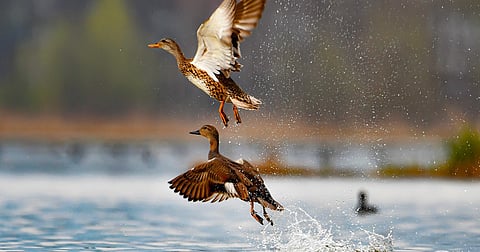

Lack of water due to excess deficit rainfall at the Hokersar wetland in the Kashmir Valley in recent years has impacted the arrival of migratory bird populations in the region.
The Hokersar wetland is a Ramsar site and is spread across nearly 13.75 square kilometres (sq km), down from 18.13 sq km recorded in 1969.
According to the Ramsar Site Information Service, the wetland is the only site with the remaining reedbeds of Kashmir. It serves as a pathway to 68 waterfowl species such as little cormorant, common shelduck, large egret, great crested grebe, and other birds migrating from Siberia, China, Central Asia and Europe.
The wetland is a crucial source of food, offering spawning grounds and nurseries for fish along with breeding habitat.
According to the India Meteorological Department (IMD), Kashmir is facing a rainfall deficit of 81 per cent.
Between the first and third week of October, the Srinagar district where Hokersar is located has faced 36 per cent and 96 per cent rainfall deficit.
In 2023, the district had experienced normal rainfall of 131 mm, according to IMD data. However, in 2022, the deficit was again 96 and 89 per cent for the same time frame.
Experts said that the lack of rainfall alone is not responsible for impacting the arrival of migratory birds.
Reyan Sofi, a bird watcher who has been closely monitoring the migratory birds in the wetland since 2016, said, “By far by this time of year, over a lakh birds arrive and increase as winter progresses. They numbers reach in millions by the end of the season in March and April, when these birds leave for their journey further.”
As many as 232 species of birds have been recorded to have arrived on the wetland, he told Down To Earth. According to a study published in the journal Plant Archives in 2018, wetland shelters about two million migratory waterfowl species each year.
But this season, only about 500 birds of a handful of species have arrived said Sofi. “It can be safely said the number of migratory birds so far have been the least since 2016,” he added.
“The shortage of water usually occurs post December-January as water recedes. But this year, it has been observed from October itself,” he observed.
Sofi explained that illegal sand mining, degradation of habitat and encroachment have added to the woes of the region, which is already experiencing deficit rainfall.
“The water from upstream Doodhganga (from the east) and Sukhnag Nallah (from the west) that provide water to the wetland has reduced. Also, mining activity has resulting in opening up a nullah that drains the water from the wetland,” he said.
Raja Muzaffar Bhat, a Right to Information activist from Kashmir told DTE that encroachments, illegal dumping of sewage in the water and mining has resulted in further degradation of the wetland.
Bhat said mining has increased the width of the streams that feed the wetland from 15 metres to 30-50 metres in some stretches. The water flow adds silt to the water body, he added.
In October 2021, Bhat had also raised the issue of illegal mining at the Shaliganga Nallah, a stream feeding the wetland. After this, the National Green Tribunal (NGT) had called a halt to the operations.
“The wetland has been used by locals for livelihood purposes and its conservation and protection must become a priority,” he said.